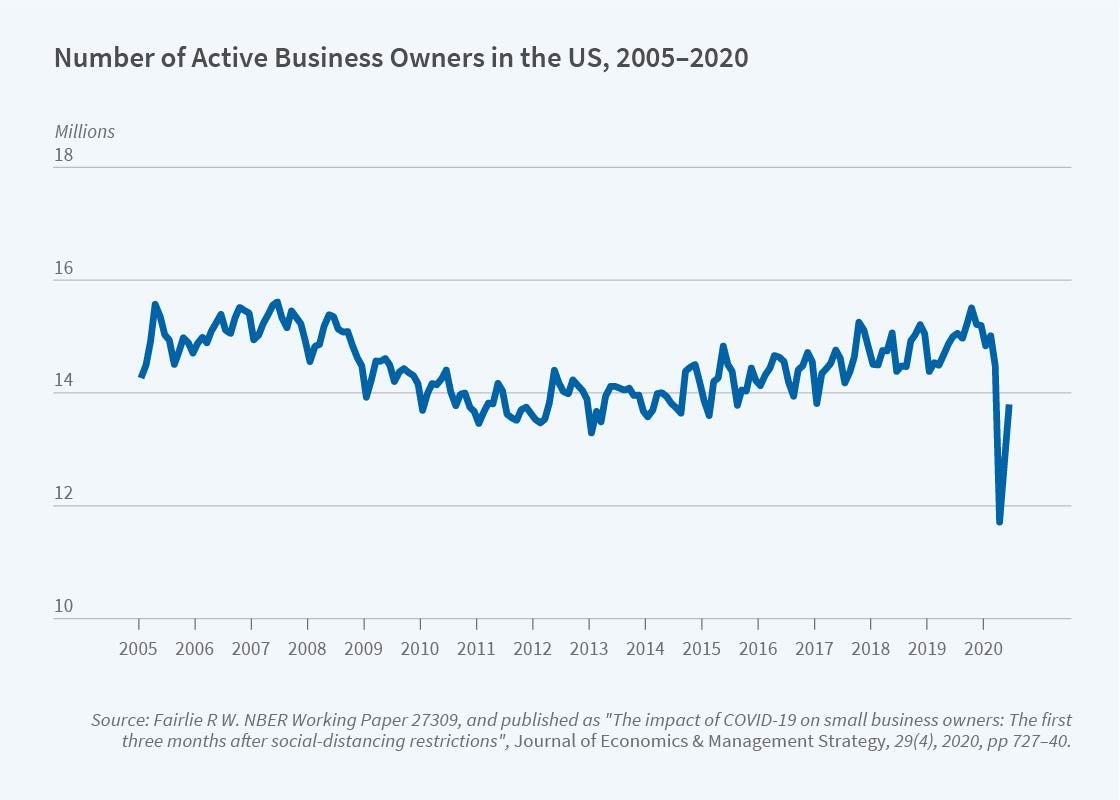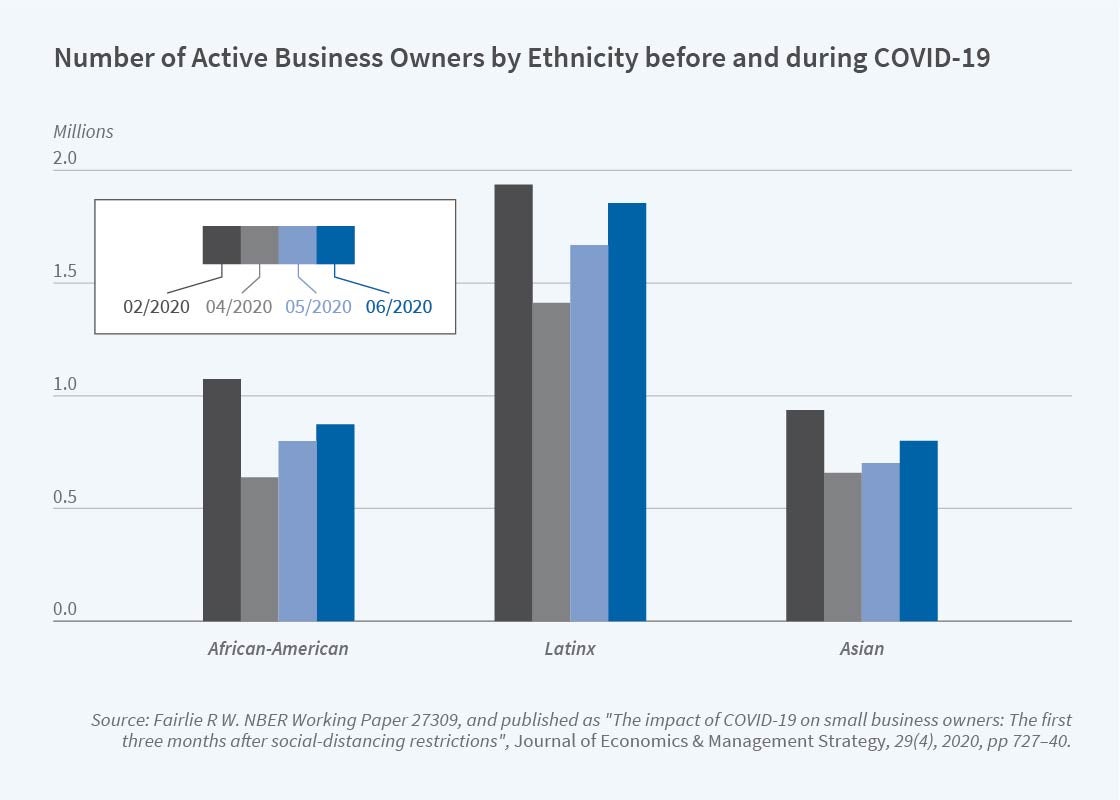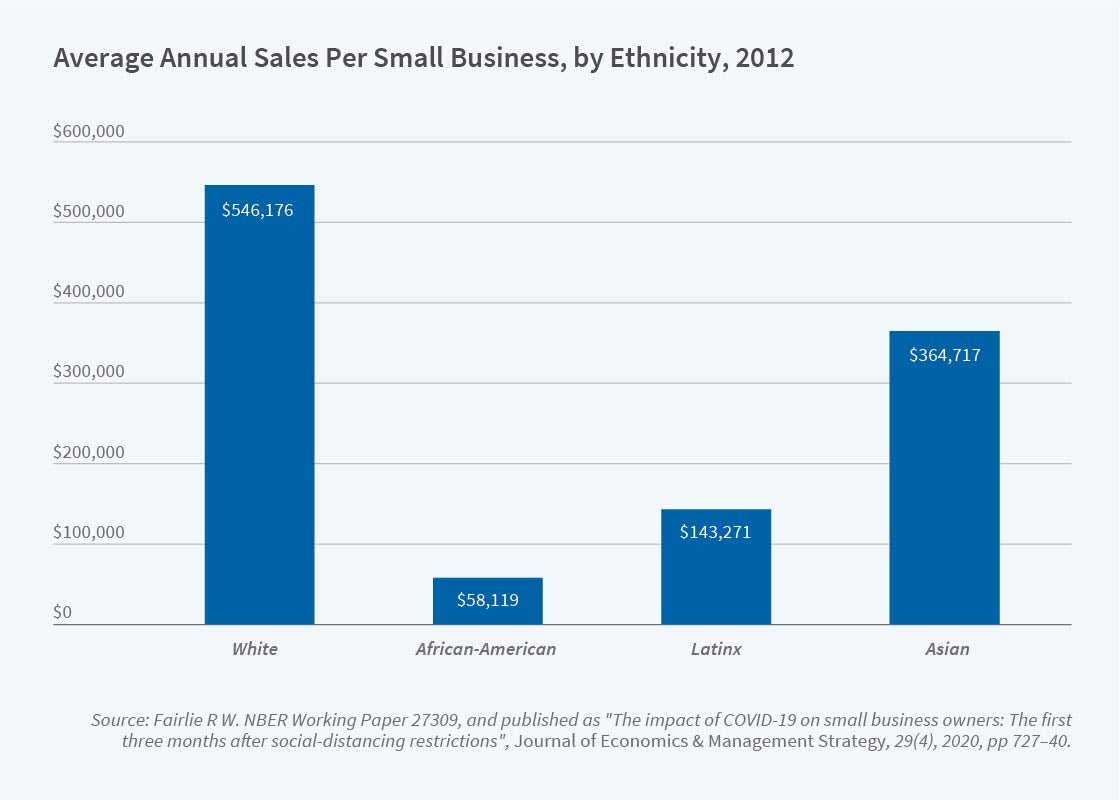COVID-19, Small Business Owners, and Racial Inequality
The widespread closing of businesses in the United States and around the world due to the coronavirus has been unprecedented. Stores, factories, and many other businesses have closed as a result of policy mandates, downward demand shifts, health concerns, or other factors. Although many have reopened since social distancing restrictions were relaxed, the revenues lost from the closures, the limited scale of current reopenings, and the potential for further closures in the future may lead to a wave of permanent small business closures with disproportionate impacts by race, gender, and nativity.
In several recent papers, I examine the impacts of COVID-19 on small business owners, using timely microdata from the Current Population Survey (CPS) and administrative data from the Small Business Administration. These new papers build on my longstanding research agenda on entrepreneurship, racial inequality, and small business policy. This summary reviews selected papers from both recent and earlier work.
Early Stages of the Pandemic
On March 19, 2020, the state of California imposed shelter-in-place restrictions, with New York State following the next day. By early April, most states had imposed social distancing restrictions that closed “nonessential” businesses and added to consumer health concerns in the emerging pandemic. Using CPS microdata, I examine how COVID-19 impacted small business owners in mid-April 2020, the first month to capture these changes.1 Figure 1 shows that the number of working business owners plummeted from 15 million in February 2020 to 11.7 million in April 2020, the largest drop ever; the entire Great Recession only resulted in a drop of 5 percent. Even incorporated business owners, who tend to be more stable and growth-oriented than unincorporated owners, experienced a drop in work activity of 20 percent from February to April 2020.
Losses for businesses owned by women, racial minorities, and immigrants were especially severe [Figure 2]. African Americans experienced the largest losses: a 41 percent drop in the number of active business owners. Latinx business owners also experienced major losses: 32 percent. Immigrant business owners suffered a 36 percent drop, and female business owners 25 percent. Concentrations of female, Black, Latinx, and Asian businesses in industries hit hard by the pandemic, such as personal services, partly explain why the losses were higher for these groups than the national average. Extending the analysis into the second and third months following widespread shelter-in-place restrictions — May and June 2020 — business owner activity partially rebounded, but the disproportionate impacts from COVID-19 by gender, race, and immigrant status lingered. African Americans continued to experience the largest losses, with 26 percent of formerly active business owners still not reactivated in May and 19 percent not active in June. Job losses were also higher for minority workers.2
Overall, these early estimates of the impact of COVID-19 on small businesses indicate that losses were spread across demographic groups and types of business — no group was immune — but some groups were hit harder than others. Although there is no way to determine at present whether these business closures will be permanent, each additional month of inactivity has an impact on the revenues, profits, and employees of these businesses, and on their likelihood of ever reopening.3
Policy Response to COVID-19
Given the severity of the pandemic, the federal government provided more financial assistance to small businesses than ever previously seen. The largest programs providing funds to small businesses were the $660 billion Paycheck Protection Program (PPP) and the $220 billion Economic Injury Disaster Loan (EIDL) program. One of the goals stated in the Coronavirus Aid, Relief, and Economic Security (CARES) Act, which included the PPP and EIDL programs, was to prioritize assistance to underserved markets and disadvantaged business owners.
But did the PPP and EIDL programs get disbursed to minority communities? Frank Fossen and I explore this question using administrative data on the universe of PPP loans, EIDL loans, and EIDL advances.4 We generally find a slightly positive relationship between PPP loan receipt per business and the minority share of the population. There is some evidence that the first round of funds was disproportionately disbursed to nonminority communities and that the second was disproportionately disbursed to minority communities. Focusing on PPP loan amounts per employee, we find a negative relationship with the minority share of the population. In contrast, EIDL loans and advances, in both number and amounts, were provided positively to minority communities.
Ties to Broader, Long-Term Racial Inequality
In earlier research, I explore the link between racial inequality in business outcomes and broader racial inequality. Research on earnings inequality almost exclusively focuses on the wage and salary sector and ignores the other major way to make a living — owning a business. Ten percent of the workforce, or 12 million people, own a business rather than holding a wage or salaried job. These owners hold a disproportionate amount of total wealth and create jobs for others.
Racial disparities in business formation raise concerns about lost economic efficiency. If minority entrepreneurs face liquidity constraints, discrimination, or other barriers to creating new businesses or expanding current ones, there will be efficiency losses in the economy. Barriers to entry and expansion are potentially costly to productivity and local job creation, especially as minorities represent a growing share of the population.
In a series of papers, I use various datasets to study the causes of racial and ethnic disparities in business ownership, formation, and outcomes, focusing on the constraints that limit productivity and cause inefficiencies in the economy. Work with Alicia Robb draws on confidential, restricted-access, business-level data from the US Census Bureau to explore why Asian American-owned firms perform well in comparison to White-owned businesses, while Black-owned firms typically do not.5 We find differential access to financial capital to be the largest factor. Family business experience also plays a role in explaining differences in outcomes. In more recent work, I examine potential barriers created by human capital, wealth, demographic, geographic, and industry constraints for each group using CPS and American Community Survey data.6 I find that low levels of wealth contribute to lower rates of Black and Latinx business ownership, and that high levels of wealth increase Asian business ownership rates. Low levels of education contribute to lower business income for Blacks and Latinx, and high levels of education increase Asian business income. The Black, Latinx, and Asian populations are all relatively young compared to the White population; this also contributes to lower business ownership rates in these groups.
Using confidential and restricted-access panel data from the Kauffman Firm Survey, along with matched administrative data on credit scores, Robb, David Robinson and I explore disparities in capital use between Black- and White-owned startups.7 We find that Black-owned startups start smaller and stay smaller over the first eight years of their existence. Black startups face more difficulty in raising external capital, especially external debt. We find that disparities in creditworthiness constrain Black entrepreneurs; perceptions of treatment by banks also hold them back. Black entrepreneurs apply for loans less often than White entrepreneurs largely because they expect to be denied credit, even when they have a good credit history and in settings where strong local banks favor new business development.
Christopher Woodruff and I study why Mexican-American entrepreneurship is low in the United States even though self-employment rates are very high in Mexico.8 We find that low levels of education and wealth explain the entire gap between Mexican immigrants and non-Latinx Whites in business formation rates; together with language ability, these factors explain nearly the entire gap in business income. Legal status represents an additional barrier for Mexican immigrants.
Using census microdata from the United States, Canada, and the United Kingdom, Harry Krashinsky, Julie Zissimopoulos and I provide the first comparative examination of the education levels, business ownership, and business performance of Asian immigrants.9 We find that business ownership rates of Asian immigrants in the United States and Canada are similar to the national averages, and in the UK they are substantially higher than the national average and the highest among the three countries. Asian immigrants even from the same source country are generally much more educated in the United States than in Canada or the United Kingdom. Although there are many institutional, structural, and historical differences between the countries that might be responsible, one possibility is that the higher returns to education in the United States result in a more selective immigrant pool. Bruce Meyer and I study how groups interact in business ownership and find evidence of crowd-out between immigrant and native owners.10
Small Business Policies
Governments and donors spend billions of dollars subsidizing entrepreneurship training and development programs around the world. Arguments for subsidizing training are manifold, and span theories of allocative and/or redistributive frictions in credit, labor, insurance, and human capital markets. Dean Karlan, Jonathan Zinman and I explore the effectiveness of entrepreneurship training programs by working with US Department of Labor data from the largest random experiment ever conducted evaluating entrepreneurship training.11 After controlling for selection into training, we find that entrepreneurship training has a sizable short-term impact on increasing business ownership and reducing unemployment, but no effect on business ownership or any business outcome such as sales, exit rates, profits, or employment in the medium and long term.
Policymakers have sought to improve success among minority business owners. In the United States, for example, although they are sometimes controversial, a variety of federal, state, and local government programs offer contracting goals, price discounts, and loans to businesses owned by minorities, women, and other groups that are historically underrepresented among business owners. Aaron Chatterji, Kenneth Chay and I examine the effectiveness of affirmative action contracting programs for businesses owned by African Americans by using the staggered introduction of these contracting programs across cities in the 1980s.12 Black business ownership rates increased significantly after program initiation. On average, the Black-White gap fell 3 percentage points. Black gains were concentrated in industries heavily affected by contracting programs, and they mostly benefited those who were better educated.
Endnotes
“The Impact of COVID-19 on Small Business Owners: Evidence of Early-Stage Losses from the April 2020 Current Population Survey,” Fairlie R. NBER Working Paper 27309, June 2020. Published as “The Impact of COVID-19 on Small Business Owners: Evidence from the First Three Months after Social-Distancing Restrictions,” Journal of Economics & Management Strategy 29(4), Winter 2020, pp. 727–740.
“The Impacts of COVID-19 on Minority Unemployment: First Evidence from April 2020 CPS Microdata,” Fairlie R, Couch K, Xu H. NBER Working Paper 27246, May 2020. Published as “Early Evidence of the Impacts of COVID-19 on Minority Unemployment,” Journal of Public Economics 192, December 2020.
“The Impact of COVID-19 on Small Business Owners: Evidence of Early-Stage Losses from the April 2020 Current Population Survey,” Fairlie R. NBER Working Paper 27309, June 2020. The findings from this paper were cited in deliberations of the US Senate Committee on Small Business and Entrepreneurship and used to justify policy responses providing assistance to minority and small businesses during the pandemic. “Cardin, Cantwell, Schumer, Booker, Cortez Masto & Harris Introduce Legislation to Invest in Minority-Owned Businesses,” press release, office of Cardin B. “Governor Newsom Signs Bills to Support Small Businesses Grappling with Impact of COVID-19 Pandemic, Bolster Economic Recovery,” press release, State of California, Office of the Governor.
“Did the $660 Billion Paycheck Protection Program and $220 Billion Economic Injury Disaster Loan Program Get Disbursed to Minority Communities in the Early Stages of COVID-19?” Fairlie R, Fossen F. NBER Working Paper 28321.
Race and Entrepreneurial Success: Black-, Asian-, and White-Owned Businesses in the United States, Fairlie R, Robb A. Cambridge: MIT Press, 2008. “Why Are Black-Owned Businesses Less Successful than White-Owned Businesses? The Role of Families, Inheritances, and Business Human Capital,” Fairlie R, Robb A. Journal of Labor Economics 25(2), April 2007, pp. 289–323.
“Racial Inequality in Business Ownership and Income,” Fairlie R. Oxford Review of Economic Policy 34(4), Winter 2018, pp. 597–614.
“Black and White: Access to Capital among Minority-Owned Startups,” Fairlie R, Robb A, Robinson D. NBER Working Paper 28154, November 2020.
“Mexican Entrepreneurship: A Comparison of Self-Employment in Mexico and the United States,” Fairlie R, Woodruff C. NBER Working Paper 11527, August 2005, and in Mexican Immigration to the United States, Borjas G, editor. Chicago: University of Chicago Press, 2007.
“The International Asian Business Success Story? A Comparison of Chinese, Indian and Other Asian Businesses in the United States, Canada and United Kingdom,” Fairlie R, Zissimopoulos J, Krashinsky H. In International Differences in Entrepreneurship, Lerner J, Schoar A, editors, pp. 179–208. Chicago: University of Chicago Press, 2010.
“The Effect of Immigration on Native Self-Employment,” Fairlie R, Meyer B. NBER Working Paper 7561, February 2000, and Journal of Labor Economics 21(3), July 2003, pp. 619–650.
“Behind the GATE Experiment: Evidence on Effects of and Rationales for Subsidized Entrepreneurship Training,” Fairlie R, Karlan D, Zinman J. NBER Working Paper 17804, August 2012, and American Economic Journal: Economic Policy 7(2), May 2015, pp. 125–161.
“The Impact of City Contracting Set-Asides on Black Self-Employment and Employment,” Chatterji A, Chay K, Fairlie R. NBER Working Paper 18884, March 2013, and Journal of Labor Economics 32(3), July 2014, pp. 507–561.





